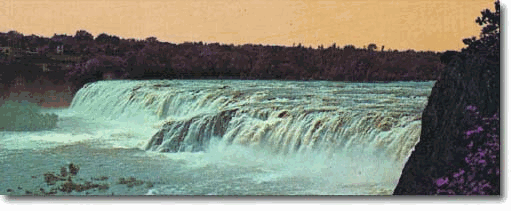
Is it possible to live in a city and never see its most famous landmark?
I spent 11 years in the former mill town of Cohoes, whose namesake is the Cohoes Falls, the second most powerful waterfall in New York State. But when I was coming of age in the late 1950s and early 1960s, our city's falls at the junction of the Mohawk and Hudson Rivers were leased to a state power company and their flow was often reduced to a trickle. Cohoes didn't promote the falls as a tourist attraction because nobody knew when they might run, and the nuns at my primary school never mentioned their role in the Iroquois Confederacy.
So the Cohoes Falls, revered by Native Americans and travelers from former centuries, were a silent backdrop to my youth, which explains why my parents never took me to "Mill Hill" where one could view them.
But several years ago while researching my first novel, The Voice I Just Heard, I decided to set the book in and around my hometown. I drove north from Maryland to spend the holidays with my mother, and while her turkey was roasting on Christmas morning, my husband and I set off to find the falls that had fueled the city's long-defunct mill industry.
What we discovered after we drove over the Cohoes-Crescent Road, parked on Cataract Street and strolled to the crumbling brick overlook stunned us: majestic white water frothing over a 1,000-foot precipice, then crashing down a 75-foot drop. And at the bottom of the rapids was a perpetual rainbow slanting across the rising mist.
It was a magical sight, and as I later learned while doing research, the falls' history was equally impressive. And I also found out that during seasons of excess precipitation, such as that snowy winter, the falls were allowed to run free.
Over time I discovered that the Cohoes Falls, flanked by cliffs of blue-black shale, were the most famous cataract in the New World when the Dutch arrived in 1630. They were the sacred site where the Peacemaker, a holy man, convinced the five tribes of the Haudenosaunee (Iroquois) to forge their historic confederacy (exact date unknown). Benjamin Franklin later visited Cohoes to confer with Native American leaders about the democratic principles espoused by the Iroquois League, and George Washington made a trip to the falls during his 1773 tour of the northern states.
In the 19th century, Cohoes morphed into a factory town settled by Irish and French-Canadian immigrants when city fathers harnessed the falls to run the turbines in the nascent mill industry. Harmony Mill Number Three presently became the largest single cotton mill in the United States, and it remains a marvel of ornate Victorian architecture on the banks of the Mohawk. The immense brick building has been preserved and it now boasts several floors of modern river-view apartments.
During the last decade, the dynamic Cohoes mayor, John T. McDonald, III, began to champion the falls, and he was instrumental in persuading the new leaseholder, Canada's Brookfield Power, to release more water, allowing residents and tourists to enjoy the city's natural wonder on a regular schedule. Brookfield rehabbed the original brick overlook at School and Cataract Streets, an enclave of Victorian row houses with landmark status, and also created Falls View Park which allows visitors extraordinary access to the town's main attraction.

Photo of the Cohoes Falls from the city's website: www.Cohoes.com.
After my first visit, I read a famous 1804 poem by Thomas Moore, once the national bard of Ireland, called "Lines Written at the Cohos [sic]." I commissioned an original art song from composer Lori Laitman, which she named "Lines Written at the Falls" and recorded on her Within These Spaces album. The song may be bought at iTunes, and as sung by soprano Sari Gruber it lends musical power to Moore's words. Here's the last elegiac verse:
Oh, may my falls be bright as thine!
May heaven's forgiving rainbow shine
Upon the mist that circles me,
As soft, as now it hangs o'er thee!
My novel incorporates the falls, the poem, the song and it salutes a waterfall that has thrilled new tourists as local, state, and federal officials finally began to recognize -- and promote -- its worth. If you're visiting the capital district of New York, don't miss the city of Cohoes, eight miles from Albany.
Travel tips: Make sure to see both the Cohoes Falls and the town's restored Victorian opera house, the Cohoes Music Hall, on Remsen Street. Then stroll down the block for lunch or dinner at the historic Smith's Restaurant. The city also features excavated portions of the Erie Canal on North Mohawk Street across from Harmony Mill Three, and you'll find handsome Victorian homes on Columbia Street.
Spring is the ideal time to see the falls because as the snow melts, the rapids are fierce. I've visited at all seasons, though, and the landscape is always fascinating, even when the falls are dry.
For information about The Voice I Just Heard, a valentine to Cohoes, visit me at www.susandormadyeisenberg.net.